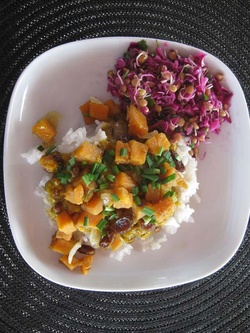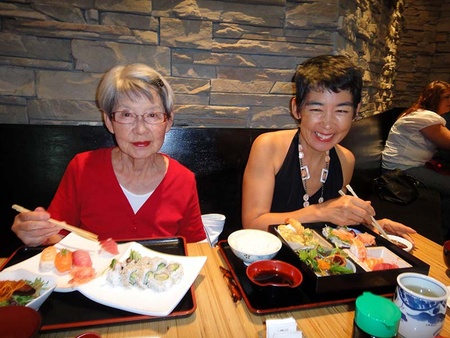I was nurtured, body and soul, by the food of my mother and grandmother.
Junko, my mother, always health conscious, made eating fun when my sisters and I were young. She would point out the bright colors of perfectly cut and steamed vegetables, bright as jewels with a light, crisp crunch. She would hold her ear to my mouth, exclaiming in delight, “I love rabbit sound!”
Mom would ask, “how many colors can you eat?” and we would count the colors. She could make purple cabbage taste beautiful. I cannot call it red because she refined my discernment of colors and taste. She would offer us bright green trees to eat—broccoli, asparagus. Her enthusiasm was our cue that eating was joy.
Her presentation was always care-full and art-full. She never overloaded a plate, but arranged food in small mounded portions. Food looked like a flower arrangement, like a love note on a plate, precious and delectable.
What better way for a child to learn how to maintain her health throughout her life but by eating happily of many vegetables and fruits, to savor them with all the senses.
Ikuko, my Oba-chan, prepared food with a similar art. I remember her hands as light and graceful. She did many things with those hands: calligraphy, painting, crocheting, cooking, and shining my uncle Toshi’s shoes. I could feel her thoughts in the things she crocheted me. I could taste love in her food. Her hands spoke the language of love.
My young son and I lived with her and my uncle Toshi in Kyoto toward the end of her life many years ago.
Everyday I watched and learned as she prepared food for Toshi, Boone-chan, and me. When I prepare nasu, it’s her hands that I remember turning each slim half with chopsticks over the brazier. It’s the sweet savory memory of her miso sauce that I strive to match.
The way she shaped onigiri for Boone-chan and how it fit full and generous in his small chubby hands, how he closed his eyes as he filled his mouth.
She prepared a variety of dishes to accompany the steaming rice from the rice cooker, that one ultra-modern appliance of her kitchen. Whenever my uncle would return at night, tired and hungry, there was a ready feast to welcome him. Together we would watch him relish each bite and listened to the account of his day.
Oba-chan let Boone-chan and me choose dishes from her large, heavily packed china cabinet. We would take our time and choose shapes and colors to compliment the foods she prepared and there were many to choose from, each one, like the food, made by artful hands. Looking back, I realize the preciousness of the pottery and the generosity Oba-chan extended in allowing us to handle them. She taught us by example that material things are to be used and enjoyed, not saved for special occasions, that udon could become exquisite slurped from a beautiful and perfectly balanced bowl.
After she died I inherited the things which her hands touched—her favorite tea cup, her ginger grater, her crochet hooks and knitting needles, her calligraphy brush.
Today I take deep pleasure in feeding people. My husband says my food is the most satisfying for him and that love has a taste.
I live with the awareness that my hands, the things they create and serve, come from my heritage passed to me in the kitchen and at the table of my mother and grandmother—their gifts of nourishment, service, and love.
Itadakimasu!
© 2012 Amaranth Rose





